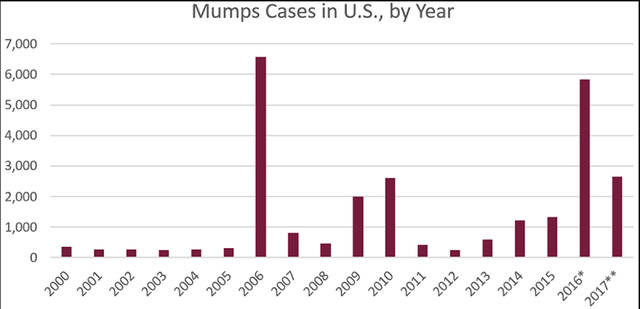HILO — Think mumps is something for people on Oahu to worry about? ADVERTISING HILO — Think mumps is something for people on Oahu to worry about? Think again. Turns out, there’s a suspected case in Puna. Thursday the Hawaii
HILO — Think mumps is something for people on Oahu to worry about?
Think again.
Turns out, there’s a suspected case in Puna.
Thursday the Hawaii Department of Health reported mumps rose to 47 confirmed cases statewide, including 46 on Oahu and one on Kauai, and it’s likely more cases will occur.
“We have actually had one suspected case — and it’s not confirmed — in a child in Pahoa,” said Bay Clinic CEO Harold Wallace Jr., without disclosing details of the patient’s age or gender.
Mumps, like whooping cough, measles and chickenpox, has come back to haunt the U.S. population, decades after the once-common ailments were cut dramatically by vaccination.
According to the Centers for Disease Control and Prevention, mumps declined steadily, after the vaccine was licensed in 1967, from more than 150,000 cases in 1968 nationwide to less than 3,000 in 1985.
Cases dropped to just 231 nationally in 2003, but outbreaks reaching the thousands nationally have occurred sporadically since then. By May 1, the CDC reported, eight states had reported more than 100 cases this year.
Mumps can cause tender, swollen salivary glands on one or both sides, the CDC reports, and fever, headache, muscle aches, tiredness and loss of appetite.
“This is a contagious illness, more contagious than the flu and spreads much the same as the flu,” said pediatric infectious diseases specialist Dr. Sarah Park, Hawaii state epidemiologist and chief of the Disease Outbreak Control Division at the Department of Health.
The CDC emphasizes catching mumps is more likely in confined, crowded conditions, such as in school, on sports teams or in a college dorm.
Mumps can still occur among people who get vaccinated. But complications are lower among them than in those who haven’t been vaccinated.
Vaccination includes a first dose at 12 to 15 months old and a second at 4 to 6 years, according to the CDC.
“Basically, teaching your immune system how to protect itself,” Park said. Adults can get a booster, but Wallace and Park both said health officials haven’t yet recommended it for the general adult population.
The Department of Health says receiving both shots provides 88 percent immunity, meaning 88 out of every 100 people vaccinated with both doses who get exposed to the virus won’t develop mumps. But 12 of those 100 still will.
Serious complications can include brain and spinal cord infection, brain swelling and temporary or permanent deafness.
Among teen or older males affected by mumps before vaccine was developed, a range of 11.6 percent to 66 percent, depending on the outbreak, developed orchitis, or swollen testicles, the CDC reports.
Mastitis affected 31 percent of teen or older females during one 1956 outbreak. And swollen ovaries in females who have reached puberty can result in loss of fertility.
The most-common mumps complication, Park said, is sterility — among both males and females.
Wallace said Tuesday that his staff has been vigilant for mumps, with heightened awareness due to the recent Oahu cases.
“It’s definitely always a concern whenever there’s an outbreak,” said Wallace, who has a master’s degree in public health.
Mumps gets confirmed through physical appearance of the patient, symptoms reported and lab tests, according to the CDC.



